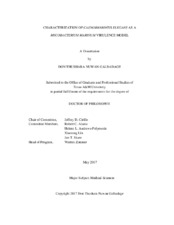| dc.contributor.advisor | Cirillo, Jeffery D | |
| dc.creator | Galbadage, Don Thushara Nuwan | |
| dc.date.accessioned | 2017-08-21T14:25:28Z | |
| dc.date.available | 2019-05-01T06:10:34Z | |
| dc.date.created | 2017-05 | |
| dc.date.issued | 2017-02-16 | |
| dc.date.submitted | May 2017 | |
| dc.identifier.uri | https://hdl.handle.net/1969.1/161240 | |
| dc.description.abstract | Mycobacterium marinum is a medically important aquatic pathogen that causes cutaneous granulomatous lesions in humans and a chronic tuberculosis-like granulomatous disease in ectotherms. M. marinum is commonly used as a model to facilitate understanding of M. tuberculosis (Mtb) virulence and pathogenesis. However, there are limitations for use of M. marinum as a model for Mtb because M. marinum have optimal growth temperature <33⁰C and they are not respiratory pathogens. Caenorhabditis elegans have been used as a host to study various pathogens because of the many molecular tools available and their genetic tractability. We infected C. elegans with M. marinum and characterized nematode morbidity and mortality. C. elegans infected with M. marinum for 24 hours display a mortality rate of >80% within two days post-infection. In contrast, nematodes infected with the non-pathogenic mycobacterial species M. smegmatis have a mortality rate of <15% C. elegans infected with M. marinum also displayed extensive pathology and colonization when compared to nematodes infected with M. smegmatis. Our observations demonstrate that M. marinum are pathogenic to C. elegans and suggest that these nematodes can be used for analysis of M. marinum virulence factors. We characterized a mycobacterial luxR1 gene locus in M. marinum that plays a role in Mtb virulence and macrophage infection. M. marinum luxR1 is transcribed in a common transcript with the pcd gene that has been suggested to play a role in biofilm formation. M. marinum mutants of luxR1 and pcd genes were characterized for their roles in growth, colony morphology, sliding motility, biofilm formation, macrophage infection and C. elegans infections. We show that the Mm-luxR1 gene plays a role in several M. marinum virulence related phenotypic characteristics. Mitogen activated protein kinase (MAPK) cell signaling pathways are critical mediators of host innate immune response to pathogens and it is known that mycobacterial species activate all major MAPK pathways upon host cell contact. Probing the role of C. elegans p38 MAPK pathway in response to mycobacterial infections revealed differences in host innate immune responses to pathogenic and non-pathogenic mycobacteria. A p38 MAPK pmk-1 mutant of C. elegans is hypersensitive to both M. marinum and M. smegmatis infection, while nematodes with an intact MAPK pathway are resistant to M. smegmatis but not M. marinum. This study establishes C. elegans as a new model for analysis of mycobacterial virulence and mechanisms of immune protection. | en |
| dc.format.mimetype | application/pdf | |
| dc.language.iso | en | |
| dc.subject | M. marinum | en |
| dc.subject | C. elegans | en |
| dc.subject | Infection | en |
| dc.subject | luxr1 | en |
| dc.subject | MAPK | en |
| dc.subject | M. tuberculosis | en |
| dc.subject | mortality | en |
| dc.subject | virulence | en |
| dc.subject | parthenogenesis | en |
| dc.title | Characterization of Caenorhabditis elegans as a Mycobacterium marinum Virulence Model | en |
| dc.type | Thesis | en |
| thesis.degree.department | College of Medicine | en |
| thesis.degree.discipline | Medical Sciences | en |
| thesis.degree.grantor | Texas A & M University | en |
| thesis.degree.name | Doctor of Philosophy | en |
| thesis.degree.level | Doctoral | en |
| dc.contributor.committeeMember | Alaniz, Robert C | |
| dc.contributor.committeeMember | Andrews-Polymenis, Helene | |
| dc.contributor.committeeMember | Skare, Jon | |
| dc.contributor.committeeMember | Lin, Xiaorong | |
| dc.type.material | text | en |
| dc.date.updated | 2017-08-21T14:25:28Z | |
| local.embargo.terms | 2019-05-01 | |
| local.etdauthor.orcid | 0000-0003-4423-7715 | |


